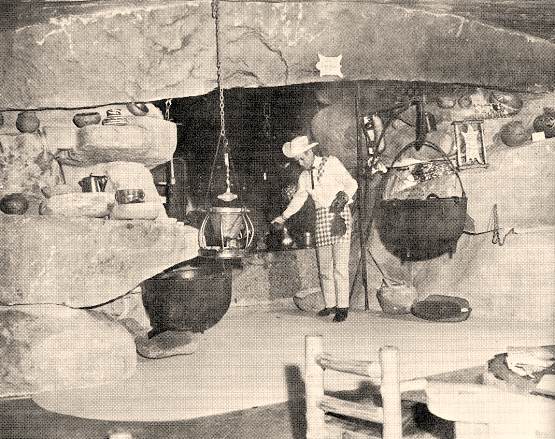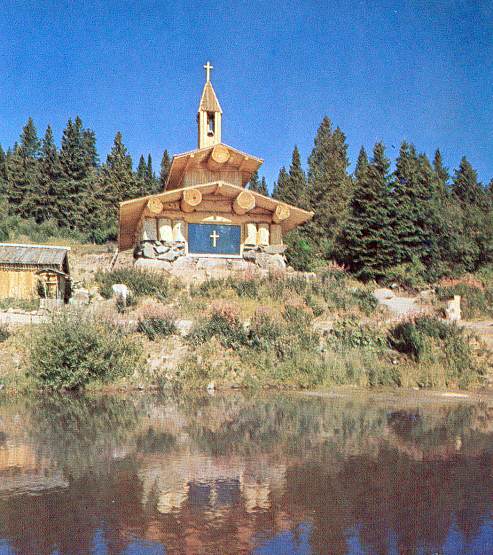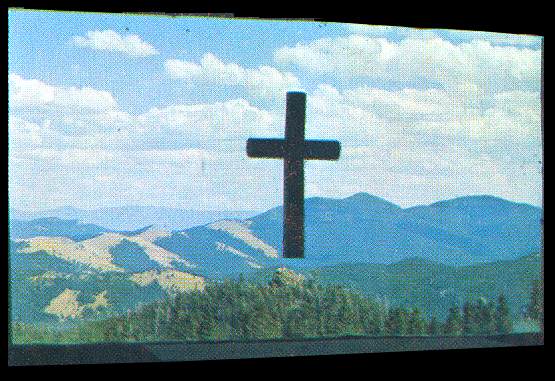|
|

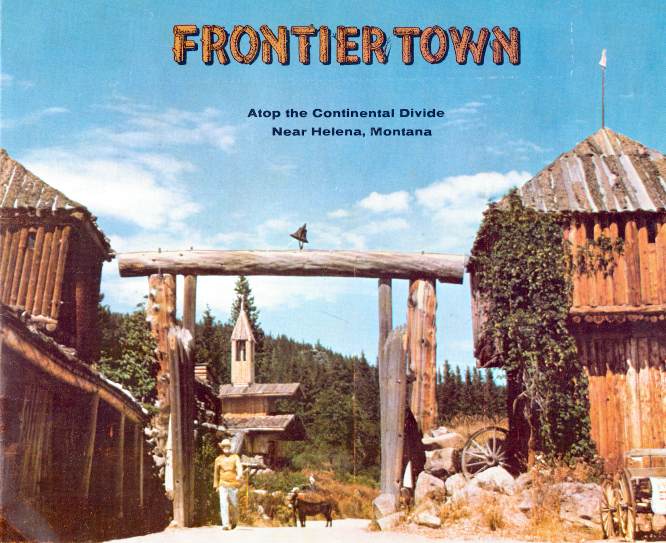
|
Frontier
Town brochure cover, 1964. Built, starting in 1946, by John
R. Quigley (1915-1979) and his wife Sue (1926-1998), Frontier
Town was not only a noted summer tourist attraction, it was
a grand example of American folk art. It was located west of
Helena, just below the summit of McDonald Pass, and is now closed
to the public.
John Quigley
is shown above walking down Frontier Town's main street. Quigley
built the attraction almost single-handedly from huge boulders
and mammoth logs. He also added fine artistic touches, such
as his expressive wood carvings.
Along with
his building and artistic talents, Quigley was a master of promotion.
He emphasized his "frontier" Montana upbringing (on
a ranch near Avon), and crafted an image of himself as a wild
mountain man. Frontier Town was advertised and promoted widely.
Some may recall the log billboards which Quigley erected along
Montana highways.
From 1951
-54, Walter and Doris Marshall operated a summer theatre at
Frontier Town, utilizing a large rotating stage which John Quigley
fashioned out of logs. The Marshalls went on to open the Old
Brewery Theatre in Helena in 1954 (see "Theaters"
on this site).
|
|
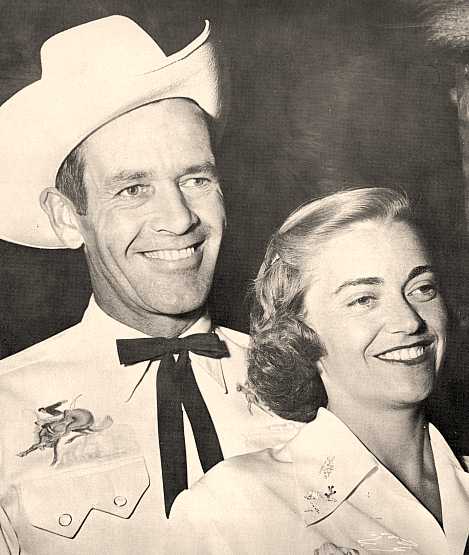
John and Sue Quigley
|
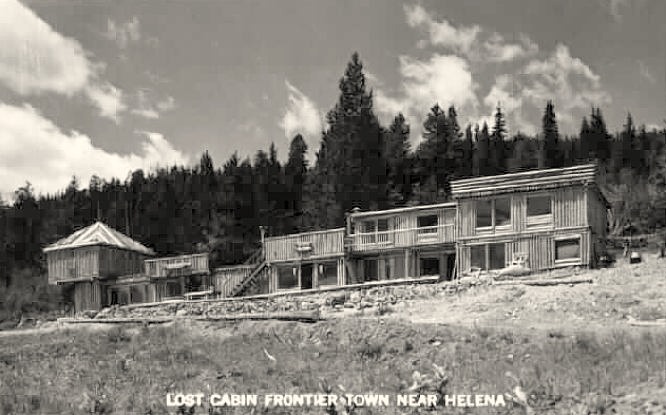
An early 1950s
view.
|
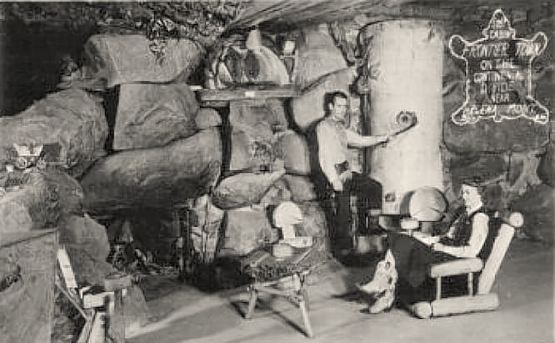
An early interior
view, with John and Sue Quigley.
|
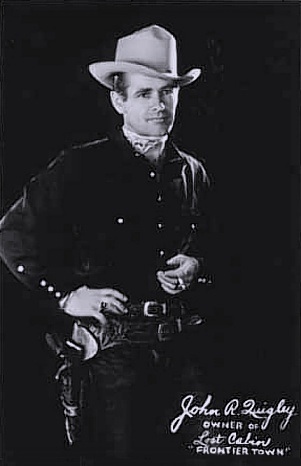
 |
John
Quigley talks about the origins of Frontier Town. John spoke with
a classic Montana accent, so if you've never heard one, this is
the real deal. Recorded in the autumn of 1979. MP3 - 7:23:00.
COURTESY OF KITTY ANN QUIGLEY TAALER
|
|
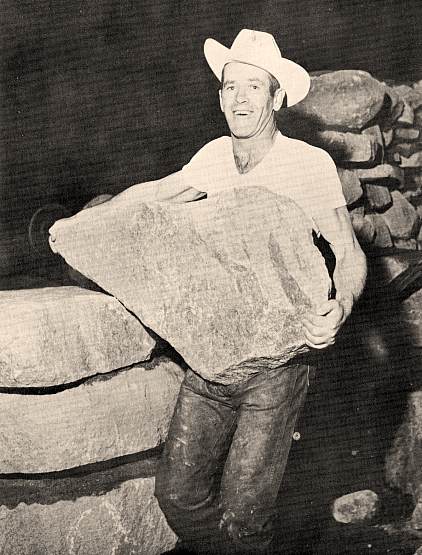
John Quigley hoisting
a stone into place.
|
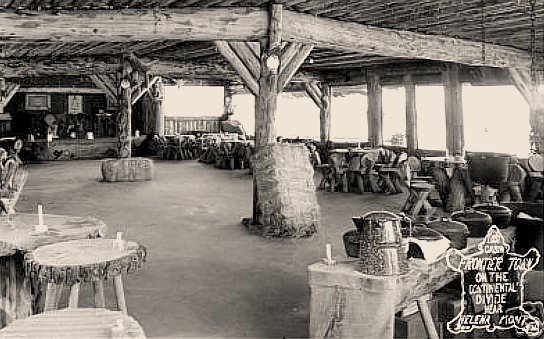
Early view of
the dining room.
|
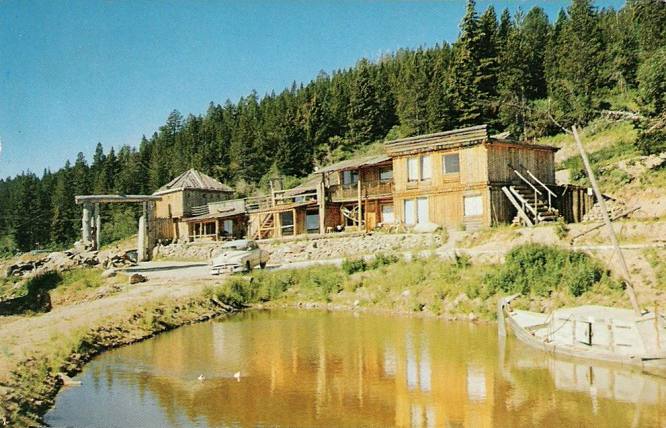
|
An
early color view of Frontier Town. Note that there is only one
blockhouse; there would eventually be four. The keelboat in
the pond was a reproduction of a Lewis and Clark Expedition
boat, which was originally made for Helena High School's annual
Vigilante Parade. It was later donated to Frontier Town (many
thanks to Kitty Ann Quigley Taaler for the information).
|
|
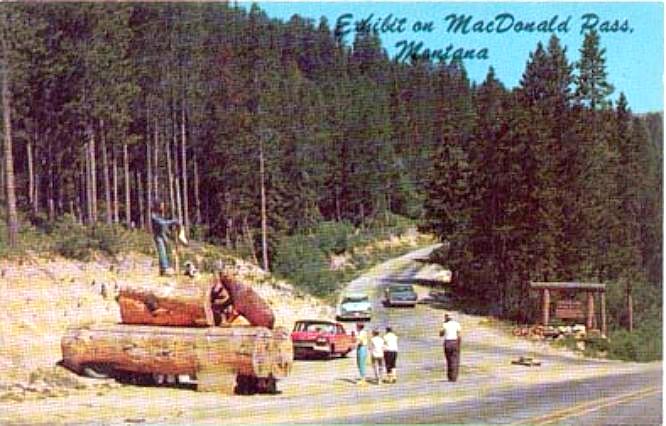
|
Frontier
Town entrance on US 12, 1960s. Shown is Quigley's animated roadside
attention-getter. Mostly carved from pine logs, and powered
by electric motors, it depicted a grizzly bear about to attack
a lumberjack and his dog. The figures jerked mechanically --
the man raising his axe, the dog jumping, and the bear lunging
-- while a loud tape-recorded loop of growling bear and barking
dog sounds echoed across the mountains. How could you not stop
for that? Many thousands did.
|
|
|
CLICK
TO HEAR THE ORIGINAL FRONTIER TOWN BARKING DOG SOUNDS
COURTESY OF KITTY ANN QUIGLEY TAALER
|
|
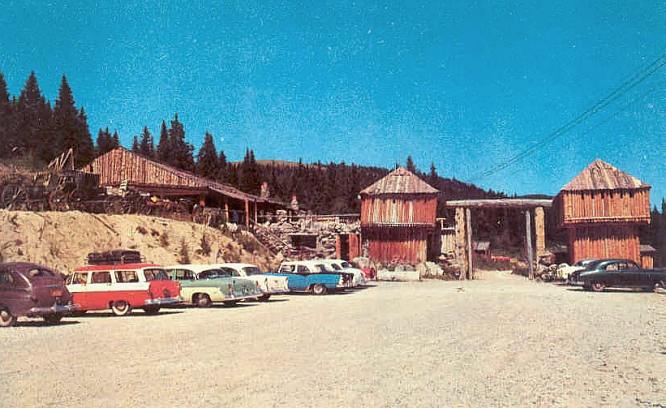
Frontier Town
parking lot and expanded two-blockhouse gate, about 1956.
|
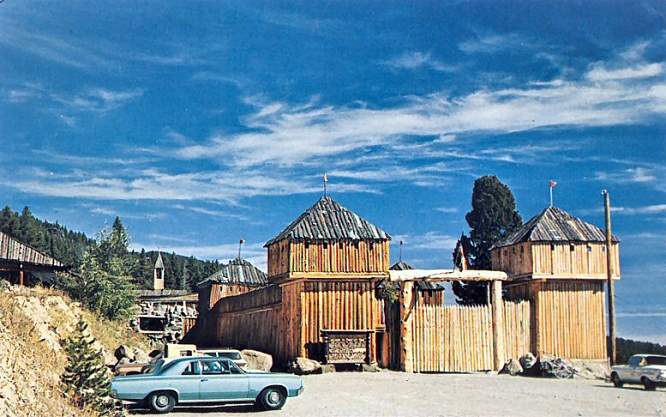
Frontier Town
parking lot and enlarged four-blockhouse gates, 1960s.
|
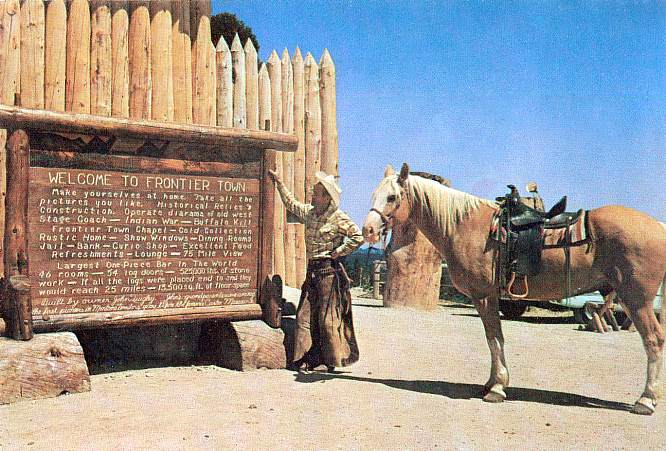
| In this ca.
1964 view, John Quigley admires the hand-carved "Welcome
to Frontier Town" sign at the entrance. The design of the
sign was similar to that of official State of Montana historical
markers. |
|
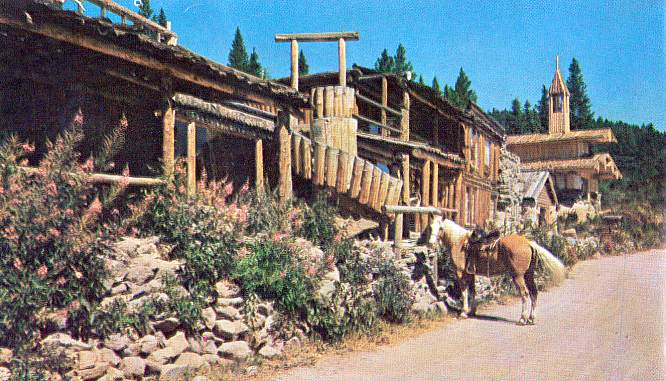
Frontier Town
main street, looking north, 1960s.
|
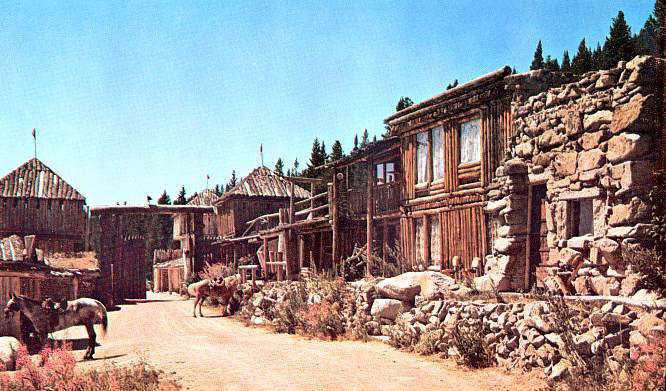
Frontier Town
main street, looking south, 1960s.
|
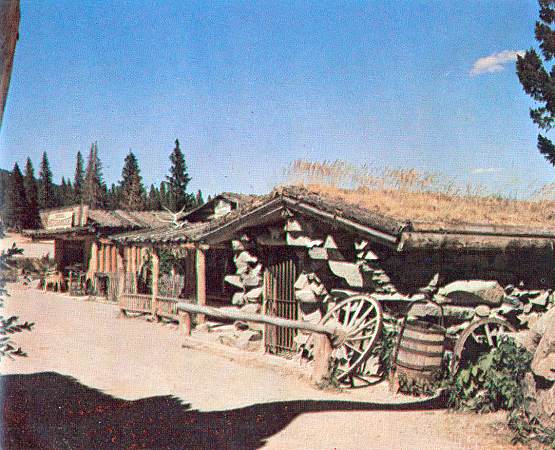
The Frontier Town
jail.
|
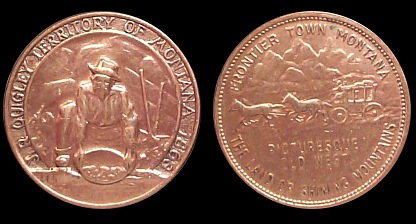
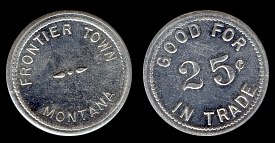
|
Frontier
Town tokens. These tokens were purchased upon entering and used
for trade. Of course, many were never used and were carried
away as souvenirs. The copper tokens, about the size of a half-dollar,
were $1.00 each.
|
|
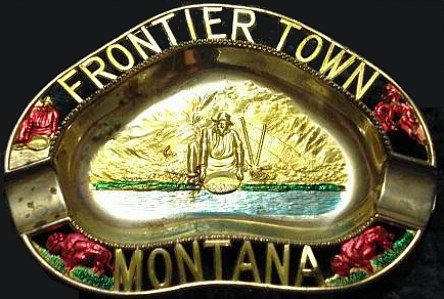
| Souvenir
ashtray from Frontier Town, 1950s-60s. The gift shop was one of
the best of its kind, capturing the essence of knotty-pine Old
West tourist kitsch. |
|
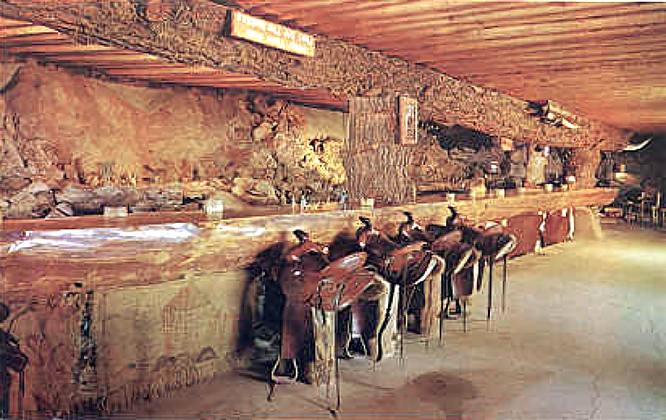
|
The main
attraction at Frontier Town was undoubtedly the 50-foot-long
split log bar, made in 1951-52 from a single Douglas Fir.
| "I
split the log during twenty below zero weather with a chain
saw. It took two days to accomplish. The bottom of the log
sits on stone pillars while the upper half is over head,
held up by log supports from the same tree. The bar top,
which has a mirror-like finish from sanding and polishing,
I did by hand. You will find two carvings in the bar top,
the first being two elk fighting over the female portion
of the herd. This I carved during the fall and winter of
1956, putting in more than 300 hours. The carving of a mountain
lion is on the lower end of the bar in front of the saddles
-- eight good riding saddles placed for bar stools. "
-- John Quigley |
No matter
which way you were traveling from Frontier Town, you had to
descend a 6,000-foot mountain pass on a winding two-lane road,
so naturally you had a drink or two. The altitude helped to
boost the effects of the alcohol, which added to the fun of
your descent.
The bar
had highly detailed animated Old West dioramas across the back,
which could be activated by inserting coins into metal boxes
on the wall.
|
"Stand
at the front of the bar and look at the back bar. You'll
see an eagle soaring over the hills and lake and dipping
down among the trees. The eagle was made by me from a
small piece of aluminum foil, suspended from a silk thread
and operated by a small motor counter-sunk in one of the
ceiling logs...
As
you look at the miniature lake amidst a setting of snowcapped
mountains, you'll see a fisherman which I made by building
a wire form, covering it with beeswax and then carving
with small knives. If you look closely you may see tension
on his line and a definite bend in his fishing pole. From
this sparkling lake, supplied with water from a mountain
spring which bubbles up right in the center of it, you
can follow the water down the rocks, under a miniature
bridge and finally over a waterfall between two huge boulders.
From there it runs outside under the floor. This spring
water is ice cold. It is used in all drinks by placing
the glass under the waterfall. Easy touch, says the barkeep!
On
the back bar are panoramic, animated dioramas to give
an added feeling of realism and originality. One is the
buffalo kill which contains twenty-six buffalo and ten
Indians, all hand-made...
Hundreds
of rocks were sorted to find enough of the right composition
and color for the jump itself...
As
you watch the buffalo falling off the cliff your attention
is suddenly drawn to a little Indian high up on a rocky
pinnacle to the left of the pishkun. He is sending smoke
signals to warn other Indians that there are no more buffalo
coming...
The
animated Indian-war diorama contains 37 figures and 7
deer-hide tepees. These figures were made from metal,
because of the high voltage electricity used to make the
gun flashes as the whites and Indians deploy in their
gun battle. In the background you may see Indian reinforcements
going through their dance ritual.
The
stagecoach, which runs the full length of the bar, is
operated on a principle similar to real cable cars which
run on endless cables and turn on turntables." --
John Quigley
|
At the
far end of the bar was a cozy nook with comfortable rustic chairs
in front of a warming stone fireplace. The stone steps leading
up to the restaurant were adjacent to the sitting area.
Mounted
on that end of the bar was a small bronze sculpture of a cowboy
cooking with a
skillet over a tiny natural gas flame. If the bartender noticed
someone admiring the cowboy, he'd tell them to look very closely
at what he was cooking. When the subject peered into the little
pan, the bartender would trigger the cowboy to spit a jet of
ice-cold water onto the rocks in front of him, splattering the
face of the unsuspecting tourist.
|
|
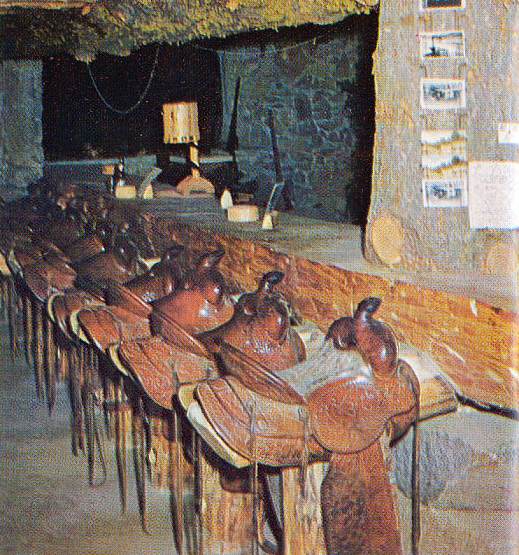
The saddle stools,
date unknown.
|
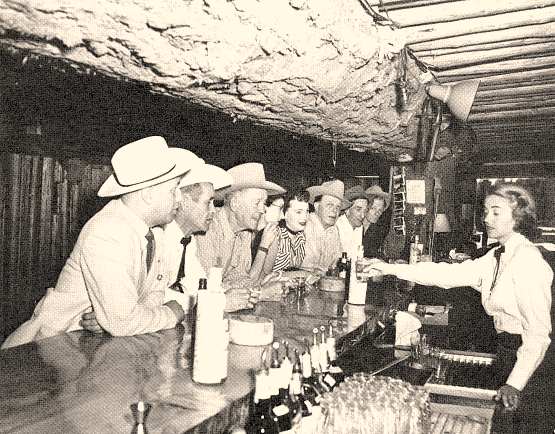
|
Frontier
Town bar, early 1960s. From left to right are: Walter H. Marshall,
John Quigley. The third man from the right is early cowboy motion
picture star Edward "Hoot" Gibson. Sue Quigley is
the barmaid.
Numerous
celebrities visited Frontier Town over the years, including
Billy Graham (although he probably didn't saddle up at the bar).
|
|
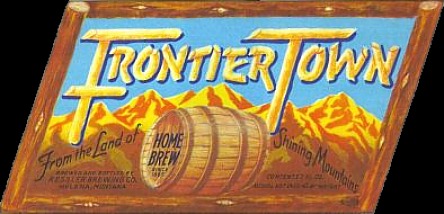
"Frontier
Town Home Brew" beer label. Probably 1950s. Brewed by Kessler
Brewing in Helena.
|
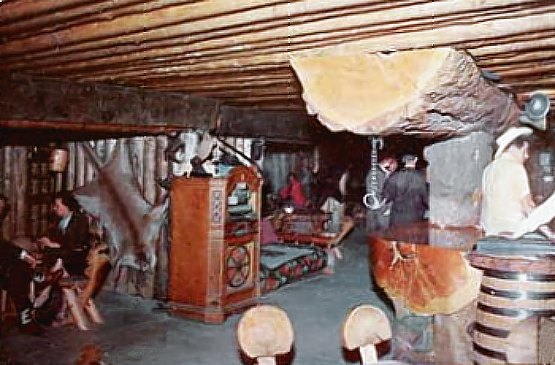
| Photo taken
from the far end of the bar, 1950s. The old jukebox was one of
the many curiosities and relics which Quigley collected and put
on display. |
|
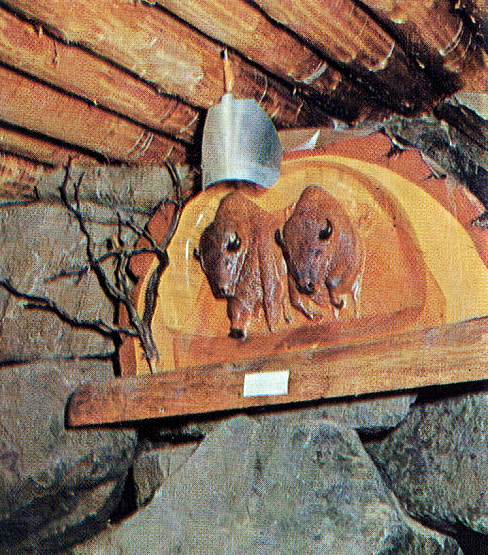
| Over the
fireplace near the bar was this relief carving of charging buffalo,
done by John Quigley in 1952. |
|
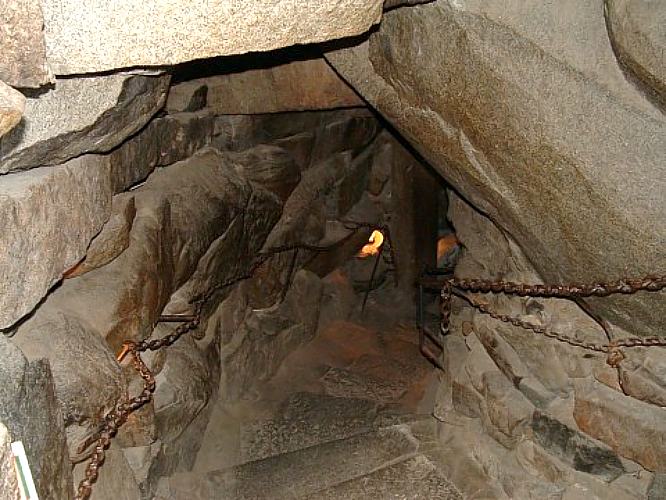
Looking down the
steps leading from the bar up to the dining room.
COURTESY OF KITTY ANN QUIGLEY TAALER
|
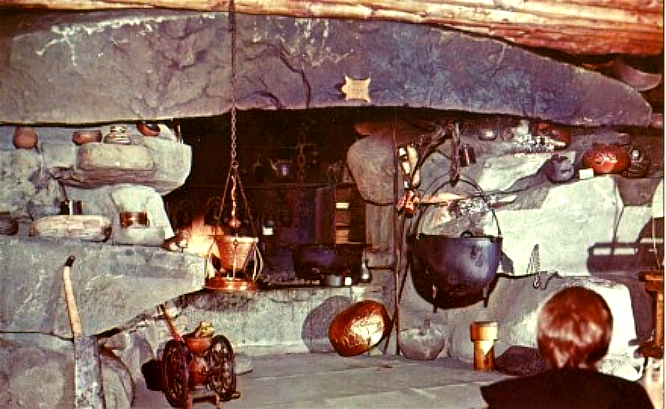 . .
|
Dining room
fireplace, Frontier Town, 1950s. The upstairs restaurant was
also noted for its construction and decor. John Quigley could
be found tending this fireside, chatting with diners and giving
kitchen tours. The dining room suffered a major fire in 1975,
but was rebuilt.
|
|
|
|
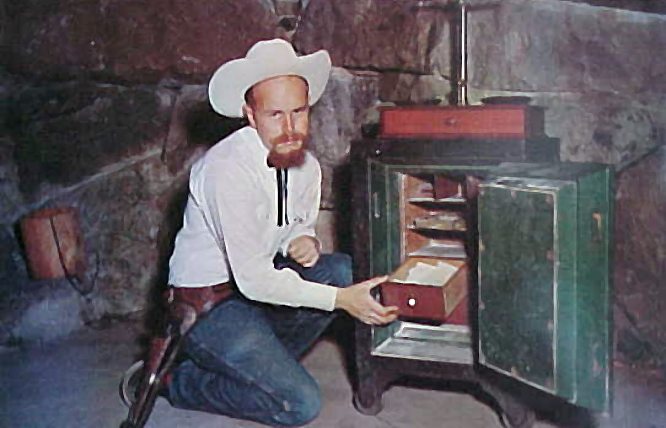
|
Frontier
Town, 1950s. Pictured is Scott, a longtime employee of Frontier
Town. John Quigley had a large collection of historical items
and memorabilia. Among them was this safe, said to be the first
in Montana Territory.
|
|
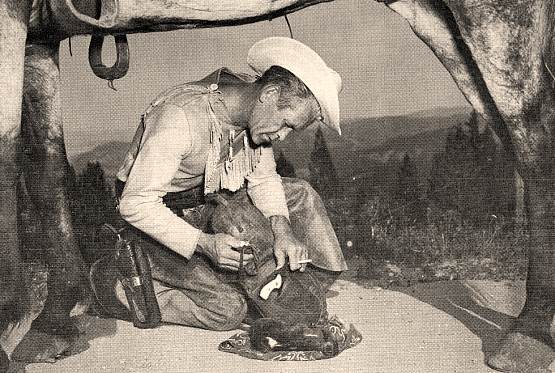
| John Quigley
in a publicity photo captioned, "Quigley, the hard-bitten
mountain man, checks his gear before a ride." |
|
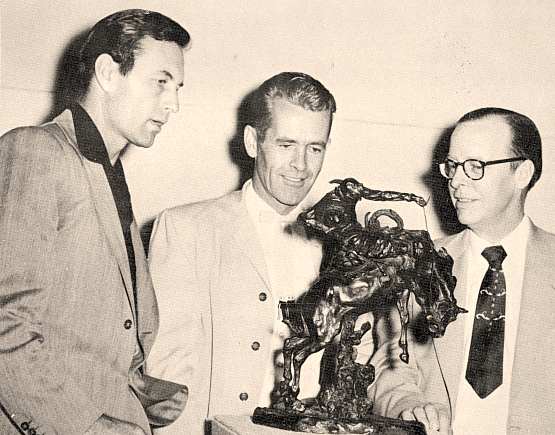
| Montana-born
movie star George Montgomery, John Quigley, and Montana author
A. B. Guthrie, 1954. They are gathered around a C. M. Russell
bronze sculpture, presumably at the Montana Historical Society
in Helena. |
|
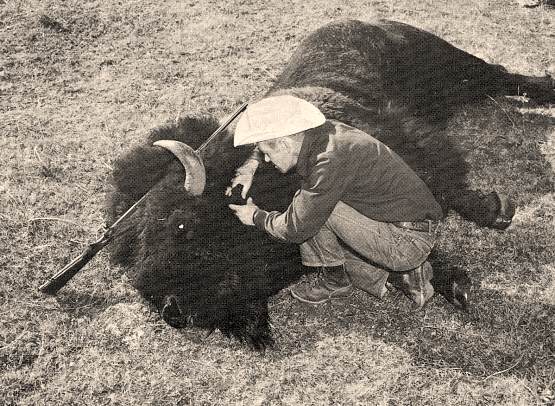
| About 1960,
John Quigley shot and killed this buffalo. He had it mounted and
mechanized, and it was apparently on the 1964 Montana Centennial
Train, which traveled to the New York World's Fair. |
|
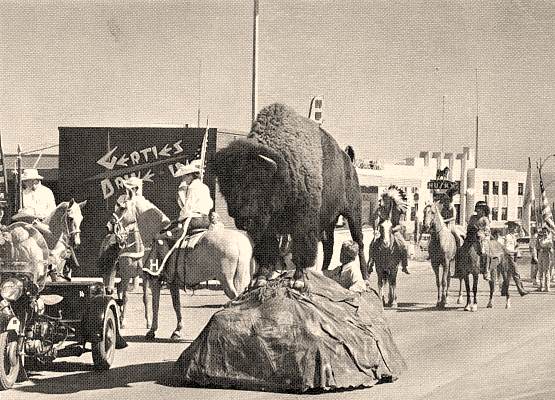
| The Quigley
buffalo in a Helena parade, early 1960s. In the background are
Gertie's Drive-in, the Husky sign at McGaffick's, and the Montana
National Guard Armory. |
|
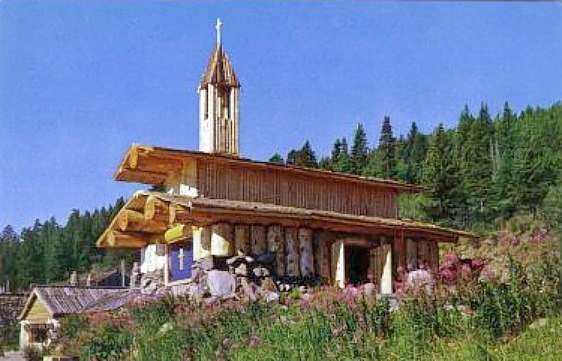
| Log Chapel
at Frontier Town, completed in 1961. Quigley said that building
the chapel was his greatest achievement. |
|
|
|
|
|
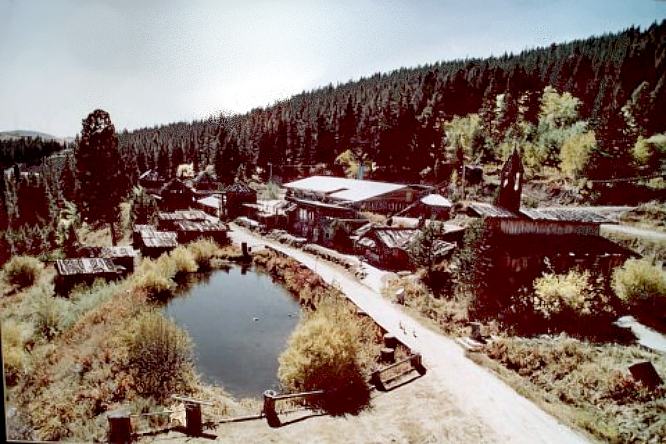
View of Frontier
Town, 1984. COURTESY OF KITTY ANN QUIGLEY
TAALER
|
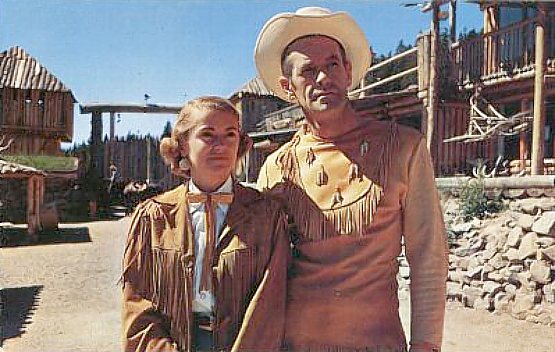
John and Sue Quigley,
1960s.

|



























 .
.